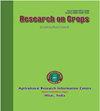南非林波波省番茄(Solanum lycopersicum)伴生细菌 Pandoraea 的 16S rDNA 分子特征
Q3 Agricultural and Biological Sciences
引用次数: 0
摘要
番茄是世界上最重要的蔬菜之一,因产量高、经济效益好而被广泛种植,因此种植面积不断增加。Pandoraea 菌可能是番茄植物的一种危险致病菌,会影响产量。它们是革兰氏阴性菌,能运动,呈杆状。2022 年,林波波大学(University of Limpopo)开展了一项研究,以确定在南非林波波省一块番茄田中发现的 Pandoraea 细菌的身份和名称。研究采用了分子方法,并利用 Chelex 方法提取了 16S rDNA 标记,从而确定了存在于南非番茄田土壤中的细菌。在使用特定引物扩增 16S rDNA 进行测试后,我们确定该细菌为 Pandoraea。我们的分析表明,在南非发现的 Pandoraea 菌株与比利时的一个种群(LR536859)有 90% 的相似性。此外,最大似然系统进化分析表明,该菌株与其他 Pandoraea 菌株同属一个群落,其 Bootstrap 值支持率很高(100)。虽然 16S rDNA 方法成功鉴定了该物种,但我们建议利用其他 DNA 标记来更全面地了解 Pandoraea 的系统发育。本文章由计算机程序翻译,如有差异,请以英文原文为准。
Molecular characters of Pandoraea, a bacterium associated with tomato (Solanum lycopersicum) using 16S rDNA from Limpopo Province, South Africa
Tomato is one of the premier vegetables in the world and is widely cultivated for higher yield and economic importance; thus, the area under cultivation is increasing. Pandoraea species can be a risky pathogenic bacterium to tomato plants, impacting the yield. They are gram-negative, motile, and rod-shaped. In 2022, the University of Limpopo conducted a study to identify and name the Pandoraea bacterium found in a tomato field located in Limpopo Province, South Africa. Molecular methods were employed, and the Chelex approach was utilized to extract the 16S rDNA marker, enabling the identification of bacteria present in the soil of tomato fields in South Africa. After conducting tests using specific primers to amplify the 16S rDNA, we have identified the bacterium as Pandoraea. Our analysis indicates that the strain of Pandoraea found in South Africa shares a 90% similarity with a population from Belgium (LR536859). Furthermore, maximum likelihood phylogenetic analysis indicates that this species is grouped with other Pandoraea species, with highly supported (100) bootstrap values. While the 16S rDNA method successfully identified this species, we recommend utilizing other DNA markers for a more comprehensive understanding of the Pandoraea phylogeny.
求助全文
通过发布文献求助,成功后即可免费获取论文全文。
去求助
来源期刊

Research on Crops
Agricultural and Biological Sciences-Soil Science
CiteScore
1.50
自引率
0.00%
发文量
93
审稿时长
1 months
期刊介绍:
The Research on Crops is a peer-reviewed journal publishing original research papers, review articles and short communications in English on all basic and applied aspects of crop sciences, agricultural water management, agro-climatology, agroforestry, agronomy, crop production, crop protection, cropping systems, food science & technology, genetics & plant breeding, horticulture, plant & soil science, plant biotechnology, plant nutrition, post-harvest management of crops, seed science, soil management & tillage, vegetables, weed science, agricultural engineering, agri-business, agricultural economics and extension, etc. The aim of the journal is to provide a forum for the scientific community to publish their latest research findings.
The manuscripts submitted for publication should not contain data older than 4 years on the date of submission.
The articles submitted for publication in this journal should not be submitted elsewhere simultaneously for publication in another journal. These should not carry any copyright material without prior permission of copyright holder.
The articles should present a complete picture of the investigation made and should not be split into parts.
There is no prescribed limit regarding the number of pages in case of full-length articles. However, the authors are advised to keep the length of their articles from 4 to 10 full printed pages of the journal.
The articles should be divided into the sub-sections: ABSTRACT, INTRODUCTION, MATERIALS AND METHODS, RESULTS AND DISCUSSION, CONCLUSIONS, and REFERENCES. Tables and figures should be appended separately at the end.
 求助内容:
求助内容: 应助结果提醒方式:
应助结果提醒方式:


